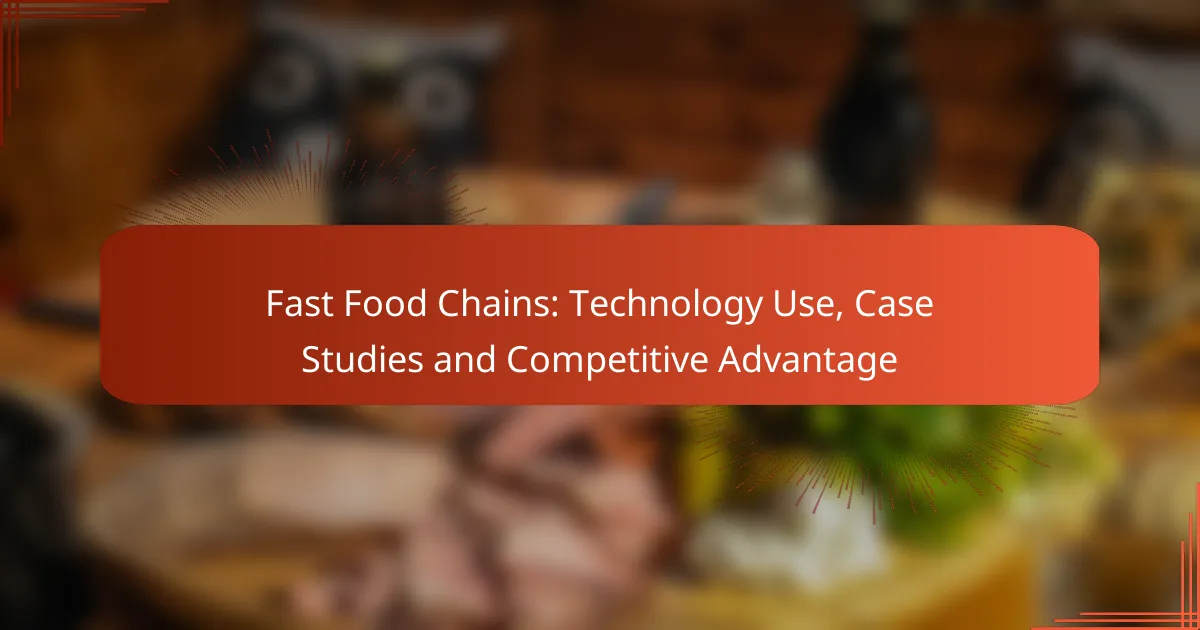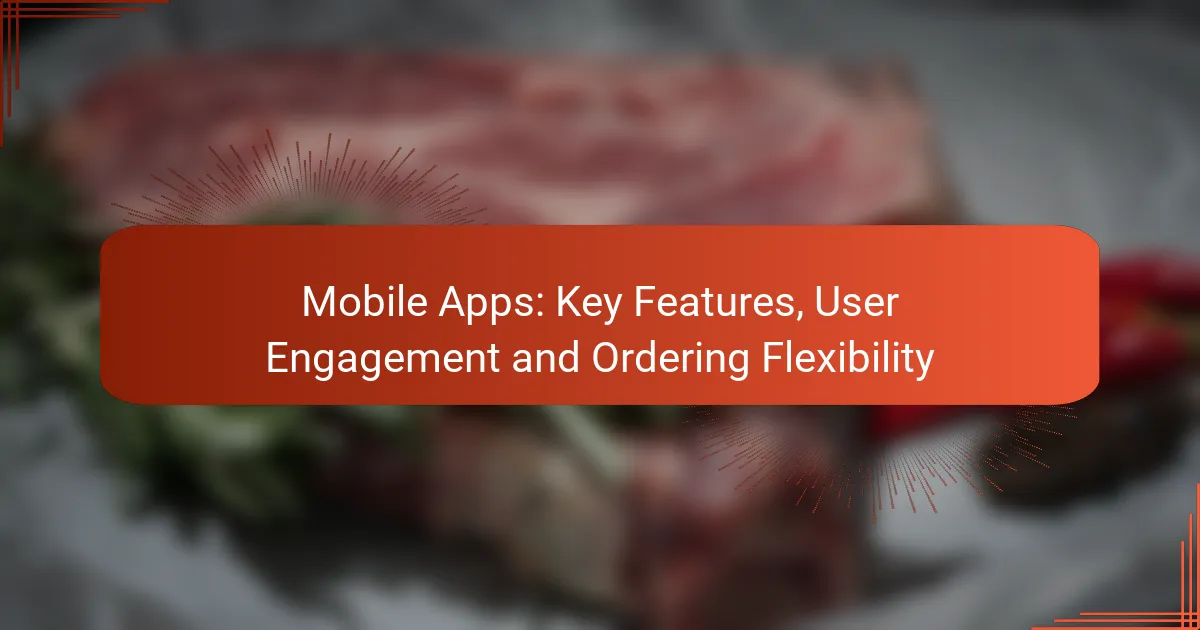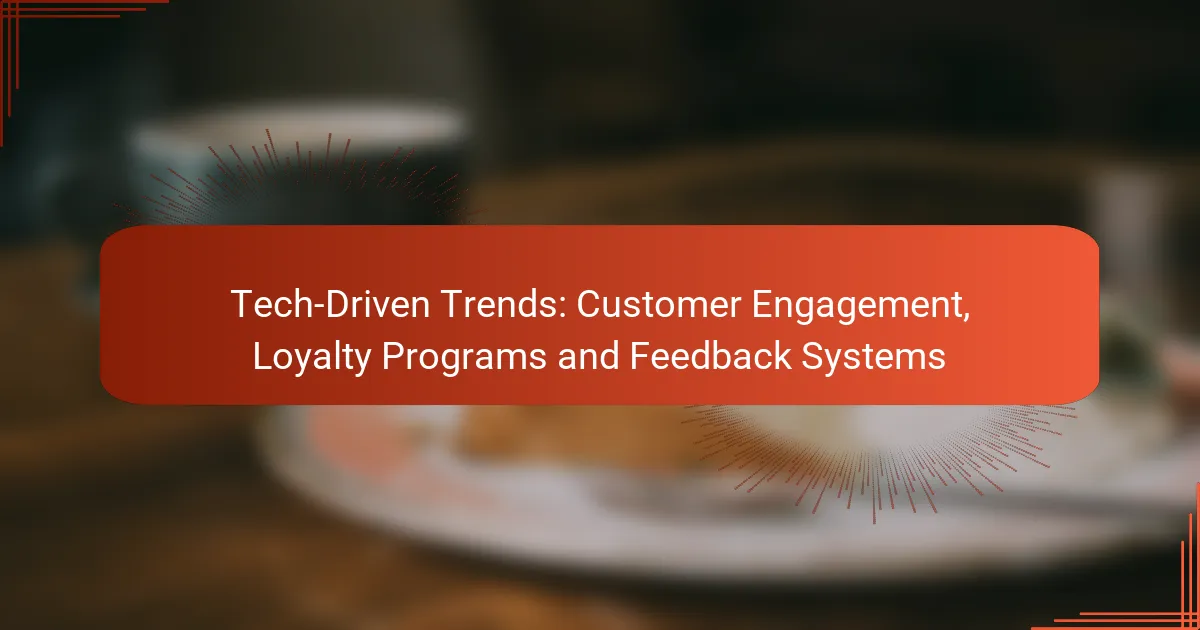Fast food chains are increasingly adopting technology to enhance customer experiences and streamline operations. By implementing innovative solutions, these businesses not only improve service speed and efficiency but also cater to the growing demand for convenience and personalization. Leading chains like McDonald’s, Domino’s Pizza, Starbucks, and Taco Bell exemplify how technology can provide a competitive advantage in the fast-paced food industry.

How are fast food chains using technology to enhance customer experience?
Fast food chains are leveraging technology to significantly improve customer experience by streamlining ordering processes, enhancing service speed, and personalizing interactions. These advancements not only increase efficiency but also cater to evolving consumer preferences for convenience and accessibility.
Mobile ordering apps
Mobile ordering apps allow customers to place orders from their smartphones, reducing wait times and enhancing convenience. Users can customize their meals, pay in advance, and choose pickup or delivery options, making the process seamless.
Popular chains like McDonald’s and Domino’s have developed their own apps, which often include loyalty programs and special promotions. This encourages repeat business and fosters customer loyalty.
Self-service kiosks
Self-service kiosks are becoming a common feature in fast food restaurants, enabling customers to place orders without interacting with staff. This technology speeds up the ordering process and minimizes human error.
These kiosks often feature touch screens that allow for easy navigation and customization of orders. Additionally, they can display nutritional information, helping customers make informed choices.
AI-driven customer service
AI-driven customer service tools, such as chatbots and virtual assistants, are increasingly used to handle inquiries and assist with orders. These systems can provide instant responses, improving overall customer satisfaction.
For example, Wendy’s utilizes AI to manage social media interactions, ensuring timely responses to customer feedback. This approach not only enhances engagement but also allows for personalized communication.
Contactless payment systems
Contactless payment systems facilitate quicker transactions by allowing customers to pay using mobile wallets or contactless cards. This technology enhances safety and convenience, particularly in the wake of health concerns.
Chains like Starbucks have integrated contactless payments into their apps, enabling customers to order and pay in advance, reducing physical contact and speeding up the service process.
Delivery tracking technology
Delivery tracking technology provides customers with real-time updates on their orders, enhancing transparency and reducing anxiety about delivery times. This feature is crucial for maintaining customer satisfaction in the competitive food delivery market.
Many fast food chains partner with delivery services that offer tracking capabilities, allowing customers to see exactly when their food will arrive. This level of visibility can significantly improve the overall delivery experience.

What competitive advantages do fast food chains gain from technology?
Fast food chains leverage technology to streamline operations, enhance customer engagement, and optimize marketing efforts. These advantages lead to increased efficiency, improved customer loyalty, and ultimately, higher profitability.
Improved operational efficiency
Technology enhances operational efficiency in fast food chains by automating processes and reducing human error. For instance, point-of-sale systems can quickly process orders, while inventory management software ensures that stock levels are optimized, minimizing waste.
Chains that implement kitchen display systems can better coordinate food preparation, leading to faster service times. Regularly reviewing operational data can help identify bottlenecks and areas for improvement, allowing for continuous enhancement of efficiency.
Enhanced customer loyalty
Fast food chains use technology to build customer loyalty through personalized experiences and rewards programs. Mobile apps allow customers to order ahead and earn points for purchases, which can be redeemed for discounts or free items.
Engaging customers via social media and targeted email campaigns also fosters loyalty. By analyzing customer preferences and feedback, chains can tailor their offerings to meet the desires of their clientele, encouraging repeat visits.
Data-driven marketing strategies
Data analytics enables fast food chains to create targeted marketing strategies based on consumer behavior. By analyzing purchase patterns and demographic information, chains can tailor promotions to specific customer segments, increasing the likelihood of conversion.
Using A/B testing for marketing campaigns allows chains to refine their messaging and offers. This data-driven approach ensures that marketing budgets are spent effectively, maximizing return on investment.
Faster service delivery
Technology significantly speeds up service delivery in fast food chains. Self-service kiosks and mobile ordering apps allow customers to place orders quickly, reducing wait times and improving overall satisfaction.
Additionally, integrating delivery services with real-time tracking enhances the customer experience. Fast food chains that utilize these technologies can respond to demand fluctuations more effectively, ensuring that customers receive their orders promptly.
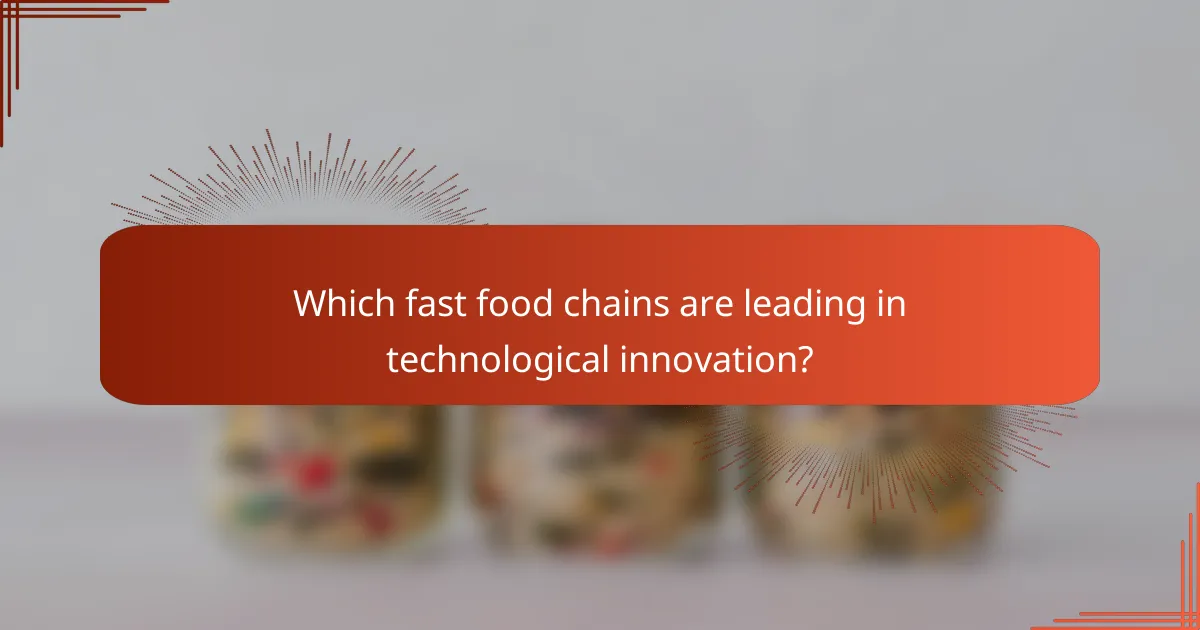
Which fast food chains are leading in technological innovation?
Several fast food chains are at the forefront of technological innovation, leveraging advancements to enhance customer experience and streamline operations. Notable leaders include McDonald’s, Domino’s Pizza, Starbucks, and Taco Bell, each employing unique technologies to gain a competitive edge.
McDonald’s
McDonald’s has embraced technology through initiatives like self-service kiosks and mobile ordering apps. These innovations allow customers to customize their orders and reduce wait times, enhancing the overall dining experience.
The chain has also invested in artificial intelligence for drive-thru services, optimizing order accuracy and speed. This technology can analyze customer preferences and suggest items, improving sales and customer satisfaction.
Domino’s Pizza
Domino’s Pizza is a pioneer in using technology for order tracking and delivery efficiency. Their GPS-enabled delivery tracking system allows customers to see real-time updates on their pizza’s journey, increasing transparency and trust.
The company has also developed an online ordering platform that supports various payment methods, including contactless options. This flexibility caters to customer preferences and enhances convenience, especially during peak hours.
Starbucks
Starbucks utilizes a mobile app that integrates loyalty rewards, mobile ordering, and payment options. This approach encourages repeat business and allows customers to skip lines, making the experience more enjoyable.
Additionally, Starbucks has implemented advanced inventory management systems that use data analytics to predict demand and optimize stock levels. This technology helps reduce waste and ensures popular items are always available.
Taco Bell
Taco Bell has made significant strides in digital innovation with its mobile app, which offers exclusive deals and allows for easy customization of orders. This app-driven approach appeals to younger consumers who value convenience and personalization.
The chain has also experimented with AI-driven chatbots for customer service, providing quick responses to inquiries and enhancing engagement. This technology not only improves customer interaction but also streamlines operational efficiency.

What are the case studies of technology implementation in fast food?
Fast food chains have increasingly adopted technology to enhance customer experience and streamline operations. Notable case studies illustrate how these implementations can lead to competitive advantages in a rapidly evolving market.
McDonald’s mobile app success
McDonald’s mobile app has transformed customer engagement by offering features like mobile ordering, exclusive deals, and loyalty rewards. This app allows customers to customize their orders and skip long lines, improving overall satisfaction.
The app’s success can be attributed to its user-friendly interface and integration with McDonald’s existing systems, enabling efficient order processing. The company reported significant increases in app downloads and customer retention rates since its launch.
Domino’s Pizza AI chatbot
Domino’s Pizza has leveraged an AI chatbot to streamline the ordering process, allowing customers to place orders via text or voice commands. This technology enhances convenience and reduces wait times, catering to the growing demand for quick service.
The chatbot uses natural language processing to understand customer preferences and provide personalized recommendations. This innovation has led to a notable increase in online orders, showcasing the effectiveness of AI in enhancing customer interaction.
Starbucks loyalty program
Starbucks’ loyalty program utilizes technology to track customer purchases and reward frequent buyers with points redeemable for free items. This program is integrated into the Starbucks app, making it easy for customers to manage their rewards and receive personalized offers.
The program’s success is evident in its ability to drive repeat business, with a significant percentage of transactions coming from loyalty members. By continually updating the program with new features and rewards, Starbucks maintains customer interest and engagement.
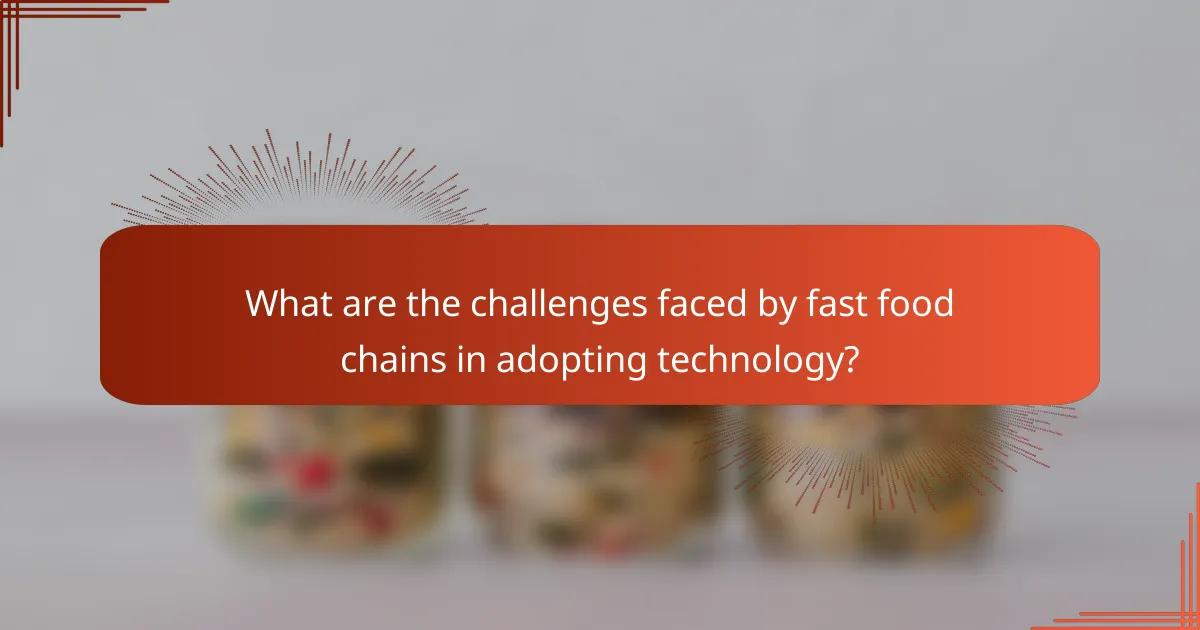
What are the challenges faced by fast food chains in adopting technology?
Fast food chains encounter several challenges when adopting technology, including high implementation costs, workforce training, and maintaining customer satisfaction. These factors can hinder the effective integration of new systems and tools that are essential for enhancing operational efficiency and competitive advantage.
High implementation costs
High implementation costs are a significant barrier for fast food chains looking to adopt new technologies. Initial investments can range from thousands to millions of dollars, depending on the scale and complexity of the technology being implemented. This includes expenses for hardware, software, installation, and ongoing maintenance.
In addition to direct costs, fast food chains must also consider potential disruptions during the transition period. For example, implementing a new point-of-sale system may require temporary downtime, which can lead to lost sales. Chains should conduct a thorough cost-benefit analysis to ensure that the long-term gains justify the upfront expenses.
To mitigate high implementation costs, fast food chains can explore phased rollouts or pilot programs. This approach allows them to test new technologies in select locations before committing to a full-scale deployment, helping to spread costs over time and minimize risk.
